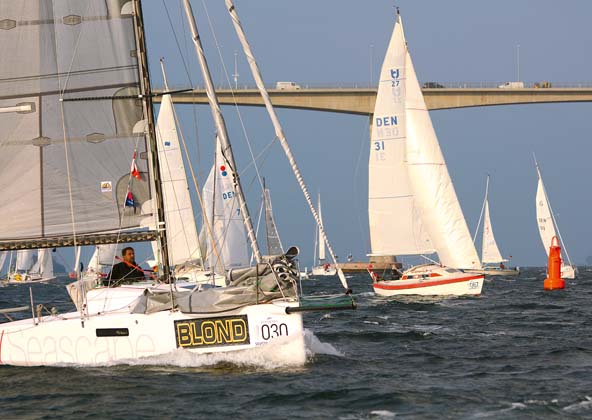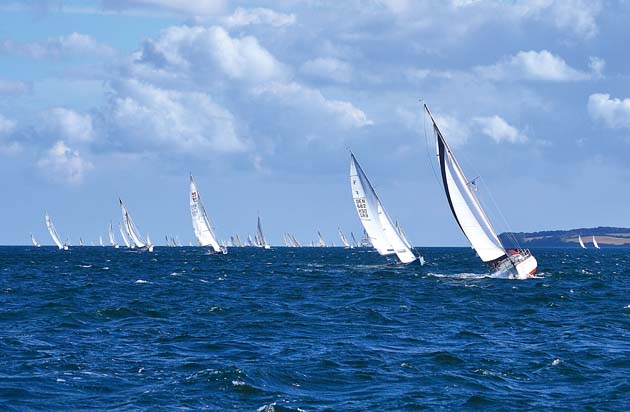To race solo round a rocky island for 24 hours non-stop in an 18ft sportsboat seems the height of bonkers. Yet the Silver Rudder claims to be the world’s biggest solo race. Øyvind Bordal certainly found it a challenge
‘If you want to feel real bliss, you have to experience real pain as well,’ so the saying goes. The thought seemed empty and stupid as I tried one more time to find a less painful seating position.
Both feet were stuffed under the hiking straps, my buttocks and lower back sent out shocks of agony every time the bow hit a wave. One aching hand was grasping the mainsheet, the other the tiller extension, and the whole thing felt like riding a bull in a rodeo. On repeat.
My thoughts had begun to drift. I lifted my head. The sun was sinking below the horizon. In an hour or so it would be dark and by then the fleet would enter the narrowest stretch of water in the race. I had been washed around in heavy weather for almost 12 hours. And the finish line was still more than 70 miles away.
Simple format
The Silver Rudder is a simple format: one boat, one crew, racing 134 miles round Funen, the second biggest island in Denmark. This year there were 330 entries, which reduced as the weather forecast became more threatening, yet 265 boats still started the race.
 Silver Rudder is the brainchild of Morten Brandt, editor of the Danish yachting magazine Bådnyt. He says: “The idea was to make an event for yachtsmen equivalent to that of marathon running and Ironman triathlon. It’s about seamanship and a personal challenge outside the comfort zone.” It certainly is that!
Silver Rudder is the brainchild of Morten Brandt, editor of the Danish yachting magazine Bådnyt. He says: “The idea was to make an event for yachtsmen equivalent to that of marathon running and Ironman triathlon. It’s about seamanship and a personal challenge outside the comfort zone.” It certainly is that!
There are seven classes: five sizes of keelboat, two sizes of multihull. Within each group it’s like a one-design race, there’s no compensation and you can show up with your boat without any handicap certificates.
The fleet is a very mixed one indeed, with hardcore racing machines racing alongside old, classic cruising vessels. Sizes this year ranged from 18ft to 46ft and I have never before competed in a race where sailors with such a varied background and experience are on the same startline. From a modern racing dinghy to sportsboats and displacement cruisers from the early 1970s with long keels and short masts made up the huge range of craft.
This year, an A-cat would probably have taken line honours, if the skipper had not hit an island during the night.
The course has only two marks, start and finish. The mission is to circumnavigate Funen via a mixture of narrow straits and open water. The first part is the tricky and shallow Straits of Svendborg, twisting eastwards through the archipelago. This takes the fleet into the Great Belt, a large sound between Zealand and Funen.
Going north through the Belt, you pass under Storebaelt Bridge, one of the biggest bridges in the world, and continue until Funen’s Head, the northern tip of the island. Here, westerly winds can be strong, and the seas can build up. This is the most exposed piece of water, and since the heading now is westerly, a long upwind leg is often on the menu.
After this, the fleet heads south through Little Belt, a relatively narrow sound between Funen and Jutland, the only piece of actual mainland in Denmark. This leg is normally sailed at night and can be challenging, because the current can be very strong and there are lots of shallows and small islands scattered around. The final leg takes you back into the western part of the Straits of Svendborg, a more or less straight line to the finish.
You can sail wherever you want, as long as you keep Funen to port at all times – although until the skippers’ meeting the evening before the start, the committee can decide to switch the direction of the race to suit conditions.
Moment of glory
The morning had been exhilarating. When the fleet left the narrow straits around Svendborg, a strong south-westerly piped over Storebaelt. My Seascape 18 was basically a keel-assisted dinghy, and since the boat was borrowed and I had only sailed her once before, I had never tried sailing with the gennaker in conditions like these.
But there we were, two identical 18s side by side, screaming at each other and encouraging each other to get that gennaker up. When the other guy started hoisting his, there was no longer a choice. So up she went. After a few seconds of frantic trimming and wiggling around, the little boat took off on a series of surfs that sent me almost directly to the front of the fleet.
Then the wind dropped a little and I was able to look back. The wake was flat and straight as an arrow and a wall of sails stretched out far behind me. In front only a very daringly rigged Mini Transat boat seemed to be faster. It was a moment of glory. I felt great!
A personal challenge
One morning long before the race, I was surfing in a different way, on Facebook. An endless parade of men like myself rolled by. They were in their late forties, a few women too, pictured in marathons, triathlons, mountain bike races or long-distance Nordic skiing competitions.
Personal challenges are the name of the game nowadays – we mid-lifers want to find the edge, leave the comfort zone. In a world where everything is possible, people will chase the limits. And we can build an identity around it, too. Everything can be shared: look at me now!
I sat there on the soft office chair thinking about it for a while. I needed the same kind of kick as everyone else. I didn’t want to sit there becoming soft and weak. Running, swimming, biking or skiing would take ages of relentless training. But sailing . . . hey, I had spent 35 years doing that. Why not take an already existing ability and try to push that to the limit?
So here I was, getting what I asked for. After almost 50 miles of reaching, hiking and trimming like a madman, we hit the north side of the island, where 20-25 knots of wind and choppy waves hit us directly in the face. Ahead was 30 miles of upwind sailing. My arms and hands were already aching and one leg was threatening to cramp. The little boat was hobbyhorsing crazily and the bow was crashing into the waves, almost coming to a standstill.
Sometimes she heeled over so much in a gust, that even the leeward twin rudder lost control. A Melges 24 was on her side just in front of me, mast almost in the waves, sails flogging and the skipper crawling around on the gunwale. One by one the boats I had passed on the reach came back with a vengeance, faster than me now with their longer waterlines and better stability.
I was hurting mentally and physically, and my glorious position earlier was slipping out of my hands minute by minute.
Nobody to help
The difference between double-handed and single-handed may seem marginal – there’s just one guy less on the boat – but believe me, the difference is huge, maybe something like having one hand instead of two, as the term implies. There’s simply nobody there to help you with anything.
That situation can be altered dramatically with a good autopilot, which makes it possible to ‘unplug’ from the helm once in awhile. You can set or drop sails, trim, eat and drink, take a leak or put some more clothes on for the night, while your electronic friend keeps the heading.
But on a Seascape 18 there’s no electrical system at all, so no autopilot. Basic things like eating or fixing stuff on the boat therefore become major projects.
After a cloudy and very dark beginning to the evening, stars began to shine all over the sky as I tried to navigate between the small islands and shallows in Lillebaelt. The wind had dropped to almost nothing, which meant I was able to sit on the cockpit floor on a spare lifevest, giving my buttocks and back a very enjoyable rest. I could even eat a little.
These races are won at night, someone once said to me. It seemed logical now, when the temptation to relax was so huge, and trimming and steering precisely in the dark was so difficult. Strangely enough, my motivation was again high, maybe boosted by the fact that some of the guys on the bigger boats didn’t seem to be paying so much attention now.
But fatigue finally set in. The last hours before sunset seemed endless. I had to shake my head and change my position again and again. The night just went on and on. Luckily, the wind slowly picked up and I decided to get the kite up, as soon as I could see anything.
Finish in the sunshine
First the gennaker, then the sun came up. And suddenly I was sailing again, gybing back and forth, feeling just happy and fine.
Four hours later, 100m from the finish line, the wind died away and the bunch of boats I was with drifted around for an hour or so. But after 28h 15m, I finally drifted across the line.
Jan Andersen was the first to cross the finish line in this year’s Silver Rudder in 15h 48m, just 12 minutes short of the race record – a record he holds himself. Andersen is a boatbuilder and sailed his own 34ft high-tech trimaran Black Marlin. I came 5th in my class.
In the harbour, there was an atmosphere of euphoria. I was as annoyed as a child to learn that one of the other Seascape 18s had beaten me, but after a cold beer the feeling of satisfaction filled in. Sails and clothes were hanging everywhere, drying in the sun. Weary, happy faces were to be seen all over, as the solo sailors shared their experiences on the docks, everybody high on finishing a race that in almost every sense had been something completely different. Maybe it’s as simple as that: just doing it is a victory.









